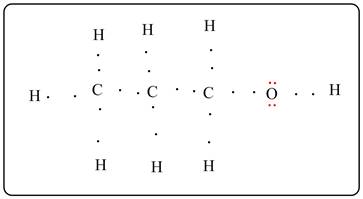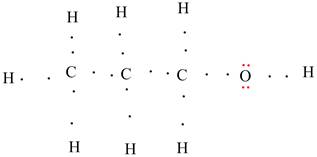
Concept explainers
(a)
Interpretation :
Structural formula of the polar molecule with molecular formula C3H8O must be drawn.
Concept Introduction :
Structural formula represents the structure of a compound in which the arrangements of atoms are shown.
(a)
Answer to Problem 6RE
Structural formula is drawn below for the polar molecule with molecular formula C3H8O.

Explanation of Solution
The molecular formula C3H8O represents isomeric ether and alcohols. Alcohols are polar than ether. Two alcohols are possible with the formula. One is primary alcohol and another is secondary alcohol. Primary alcohol (Propan-1-ol) is drawn.
b)
Interpretation :
Lewis structure must be drawn and shared electrons and lone pair electrons must be labeled.
Concept Introduction :
Lewis dot structure is the representation of molecule in which valence electrons are shown as dots.
b)
Answer to Problem 6RE
Lewis dot structure is given below.

All the dots are bond pair electrons except the two electron pairs on O atom (shown in red) are lone pair electrons.
Explanation of Solution
Lewis electron dot structure is shown. All the carbon is bonded with 4 atoms and the oxygen atom is bonded with two atoms. There are all single bonds. Two lone pairs are there on O atom.
c)
Interpretation :
The dipoles must be identified.
Concept Introduction :
A molecule will have dipoles if there is electronegativity difference between the two atoms forming the bond.
c)
Answer to Problem 6RE
The dipoles are shown.

Explanation of Solution
Oxygen will have partial negative charge as it has more electronegativity. Similarly H atom will have partial positive charge as it has less electronegativity.
Each C-H bond is also a dipole in which C is the negative pole and H is the positive pole as C has more electronegativity as compared to H.
d)
Interpretation :
The geometric shape around each carbon atom must be named.
Concept Introduction :
The geometric shape around an atom depends on the number of total electron pairs.
d)
Answer to Problem 6RE
Each carbon has tetrahedral geometry.
Explanation of Solution
Each carbon is bonded with total 4 atoms including hydrogen atom, carbon atom and oxygen atom. There is no lone pair of electrons on any carbon atom. Thus, each carbon will be tetrahedral.
e)
Interpretation :
The name of the compound must be given with proper reasoning.
Concept Introduction :
A molecule can be named using IUPAC rule. The molecule will have a trivial name also.
The molecule has three carbons and -OH as a functional group.
e)
Answer to Problem 6RE
The name of the molecule is Propan-1-ol.
Explanation of Solution
The structure is given as follows:

The numbering is done giving priority to the carbon bearing the functional (-OH) group. Total three carbons are there. The functional group is at carbon 1. So, the IUPAC name is propn-1-ol. The trivial name is n-propyl alcohol. As the -OH group is attached with normal propyl (1 degree) group.
Chapter U2 Solutions
Living by Chemistry
Additional Science Textbook Solutions
Essential Organic Chemistry (3rd Edition)
Chemistry: A Molecular Approach (4th Edition)
General Chemistry: Principles and Modern Applications (11th Edition)
Chemistry For Changing Times (14th Edition)
Chemistry: An Introduction to General, Organic, and Biological Chemistry (13th Edition)
 ChemistryChemistryISBN:9781305957404Author:Steven S. Zumdahl, Susan A. Zumdahl, Donald J. DeCostePublisher:Cengage Learning
ChemistryChemistryISBN:9781305957404Author:Steven S. Zumdahl, Susan A. Zumdahl, Donald J. DeCostePublisher:Cengage Learning ChemistryChemistryISBN:9781259911156Author:Raymond Chang Dr., Jason Overby ProfessorPublisher:McGraw-Hill Education
ChemistryChemistryISBN:9781259911156Author:Raymond Chang Dr., Jason Overby ProfessorPublisher:McGraw-Hill Education Principles of Instrumental AnalysisChemistryISBN:9781305577213Author:Douglas A. Skoog, F. James Holler, Stanley R. CrouchPublisher:Cengage Learning
Principles of Instrumental AnalysisChemistryISBN:9781305577213Author:Douglas A. Skoog, F. James Holler, Stanley R. CrouchPublisher:Cengage Learning Organic ChemistryChemistryISBN:9780078021558Author:Janice Gorzynski Smith Dr.Publisher:McGraw-Hill Education
Organic ChemistryChemistryISBN:9780078021558Author:Janice Gorzynski Smith Dr.Publisher:McGraw-Hill Education Chemistry: Principles and ReactionsChemistryISBN:9781305079373Author:William L. Masterton, Cecile N. HurleyPublisher:Cengage Learning
Chemistry: Principles and ReactionsChemistryISBN:9781305079373Author:William L. Masterton, Cecile N. HurleyPublisher:Cengage Learning Elementary Principles of Chemical Processes, Bind...ChemistryISBN:9781118431221Author:Richard M. Felder, Ronald W. Rousseau, Lisa G. BullardPublisher:WILEY
Elementary Principles of Chemical Processes, Bind...ChemistryISBN:9781118431221Author:Richard M. Felder, Ronald W. Rousseau, Lisa G. BullardPublisher:WILEY





